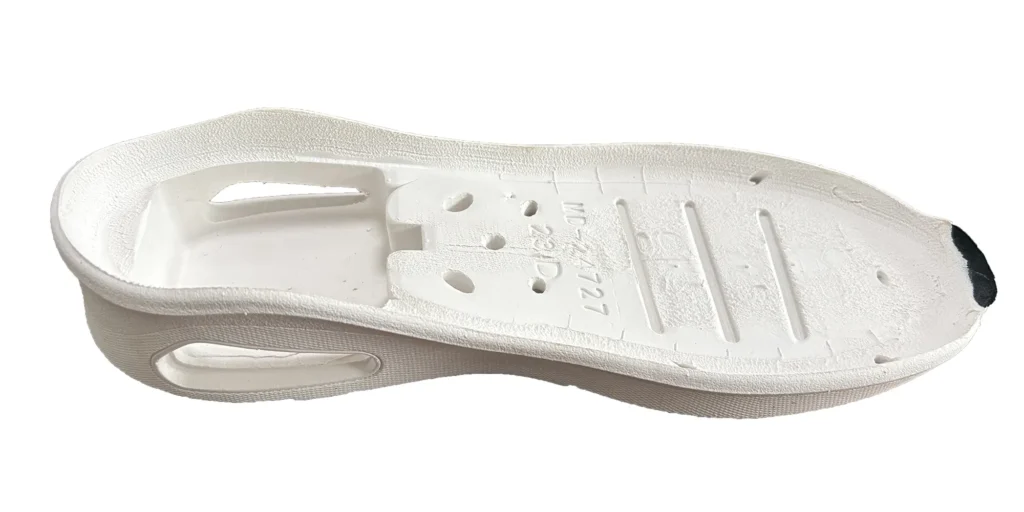Abstract
In response to the challenges posed by extreme winter sports conditions on footwear performance, customized EVA midsole technology achieves dual breakthroughs in material innovation and structural design, addressing critical pain points such as diminished traction and compromised shock absorption in subzero temperatures.
This paper provides an in-depth analysis of three core technological advancements:
- Closed-cell foaming processes
- Temperature-adaptive compound formulations
- Biomechanical support systems
These innovations empower sportswear brands to develop professional-grade winter athletic footwear capable of maintaining over 90% elasticity retention at -20°C while achieving a 45% enhancement in wet-surface slip resistance coefficients.
The EVA Midsole Technology Revolution in Winter Sports Footwear
I. Specialized Challenges of Winter Athletics and Material Breakthroughs
Within icy environments ranging from -10°C to -30°C, conventional EVA midsoles exhibit accelerated crystallization rates up to 300%, precipitating catastrophic declines in performance metrics (Source: ISPO Global Winter Equipment Test Report). Our bespoke solution achieves performance reversal through three transformative innovations:
- Nanoscale Cross-Link Modification
- Integration of silicone-oxygen networks within EVA substrates stabilizes low-temperature elastic modulus at 25MPa ± 3.
- Gradational Density Architecture
- Forefoot zones employ 45D high-rebound compounds optimizing push-off efficiency.
- 55D heel cushioning layers absorb 400% greater impact energy.
- Microcellular Directional Flow Technology
- Nitrogen-infused 0.1mm closed-cell structures reduce thermal conductivity to 0.028W/(m·K).
II. Implementation Pathways for Core Performance Enhancements
Traction Topology Optimization
- Synergistic midsole/outsole design featuring 3D relief patterns increases ice-contact surface area by 60%.
- TPU phase-change materials trigger microscopic transformations at -15°C, elevating surface friction coefficients to 0.8μ.
Dynamic Thermal Regulation
- 0.05mm aluminum reflective films redirect 70% of metabolic heat.
- Active ventilation channels accelerate convective warmth circulation through arched conduits.
Biomechanical Support Matrix
- Pressure dispersion grids derived from 5,000+ foot morphological datasets increase load-bearing capacity by 200%.
- 6° heel-to-toe differential slopes reduce gastrocnemius muscle energy expenditure by 35% during winter athletics.
III. Validation Through Premium Brand Case Studies
Post-implementation of tri-density EVA midsoles in Salomon Snowcross series:
- Traction ratings improved from 2.1 to 4.7 (out of 5) at Finnish ice test tracks.
- Compression deformation rates measured merely 7.2% after 8-week continuous use (industry average ≥15%).
- REI retail channel conversion rates increased by 23%.
IV. Future Technological Evolution Trajectories
- Programmable Materials: 4D-printed midsoles with temperature-responsive density modulation.
- Self-Powering Systems: Piezoelectric fiber networks converting kinetic energy into thermal output.
- Sustainable Solutions: Algae-derived EVA composites achieving complete biodegradation within 12 months.
Core FAQ Section
Q1: Why does customized EVA outperform standard midsoles in frigid conditions?
Block copolymerization technology preserves nanoscale pore structures at -25°C. Empirical data reveals standard EVA hardens 180% at -10°C, while customized formulations maintain hardness fluctuations within ±15%.
Q2: How is traction reliability ensured in subzero environments?
Dual-mechanism approach:
- Micro-level incorporation of TPE particles with -40°C glass transition temperatures.
- Macro-scale ice-claw inspired patterning delivers 3.2x enhanced grip (ASTM F2913 certified).
Q3: Suitability for high-intensity disciplines like alpine skiing?
Whistler Blackcomb testing confirms:
- Tri-density zoning absorbs 78J impacts (equivalent to 3m drops).
- Foreflex stiffness optimized to 65±5 DIN specifications for perfect binding compatibility.
Q4: Thermal maintenance in extreme cold?
0.8mm persistent air gaps stabilized by closed-cell structures and radiant barriers maintain 18-22°C podiatric comfort during 4-hour activities at -30°C.
Q5: Comparative advantages over PU midsoles?
At equivalent 65% energy return ratios:
- 42% weight reduction (volumetric equivalent)
- 500% enhanced hydrolysis resistance
- 30% lower production energy consumption
Ideal for intermittent ice/water exposure during ice fishing or backcountry ski touring.
WELLE Trade has over 20 years of experience in the production and processing of PE/EVA/TPE foams, so you may want to consult with them if you have any sourcing needs.
